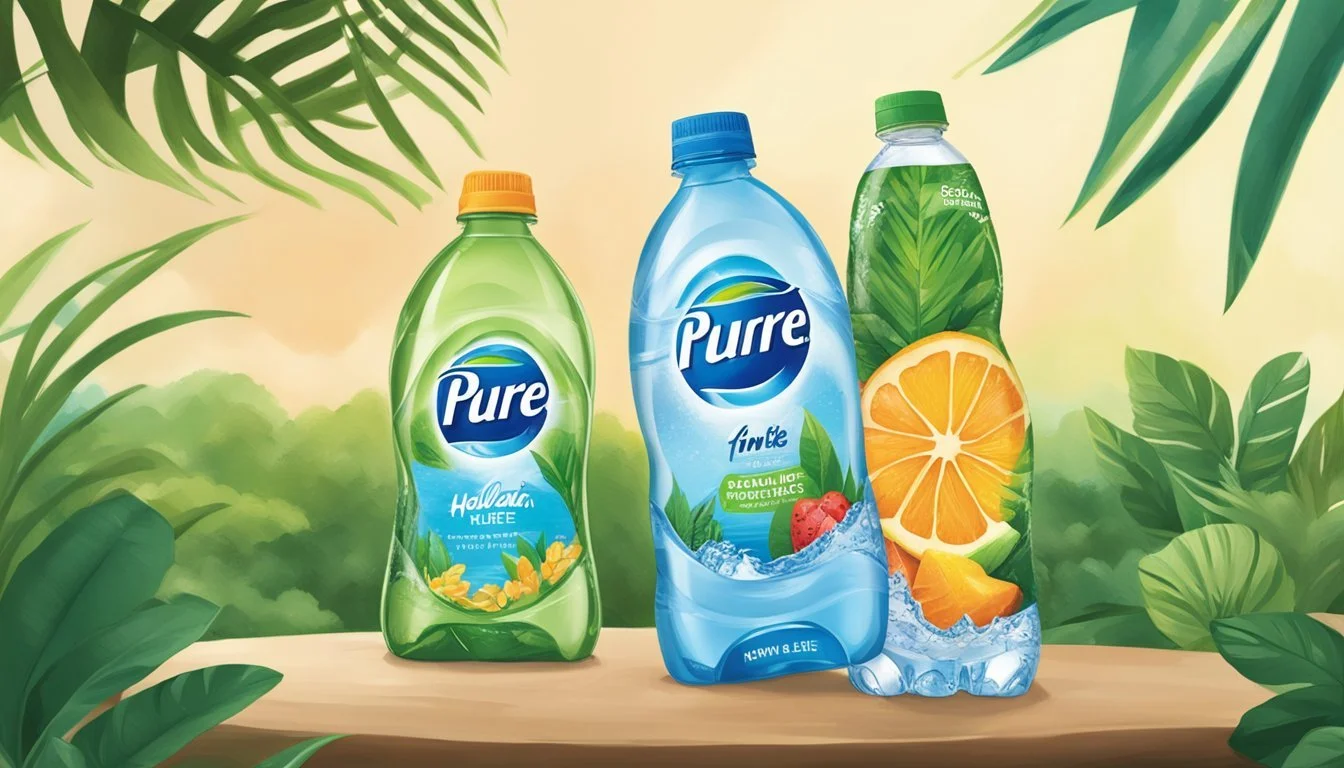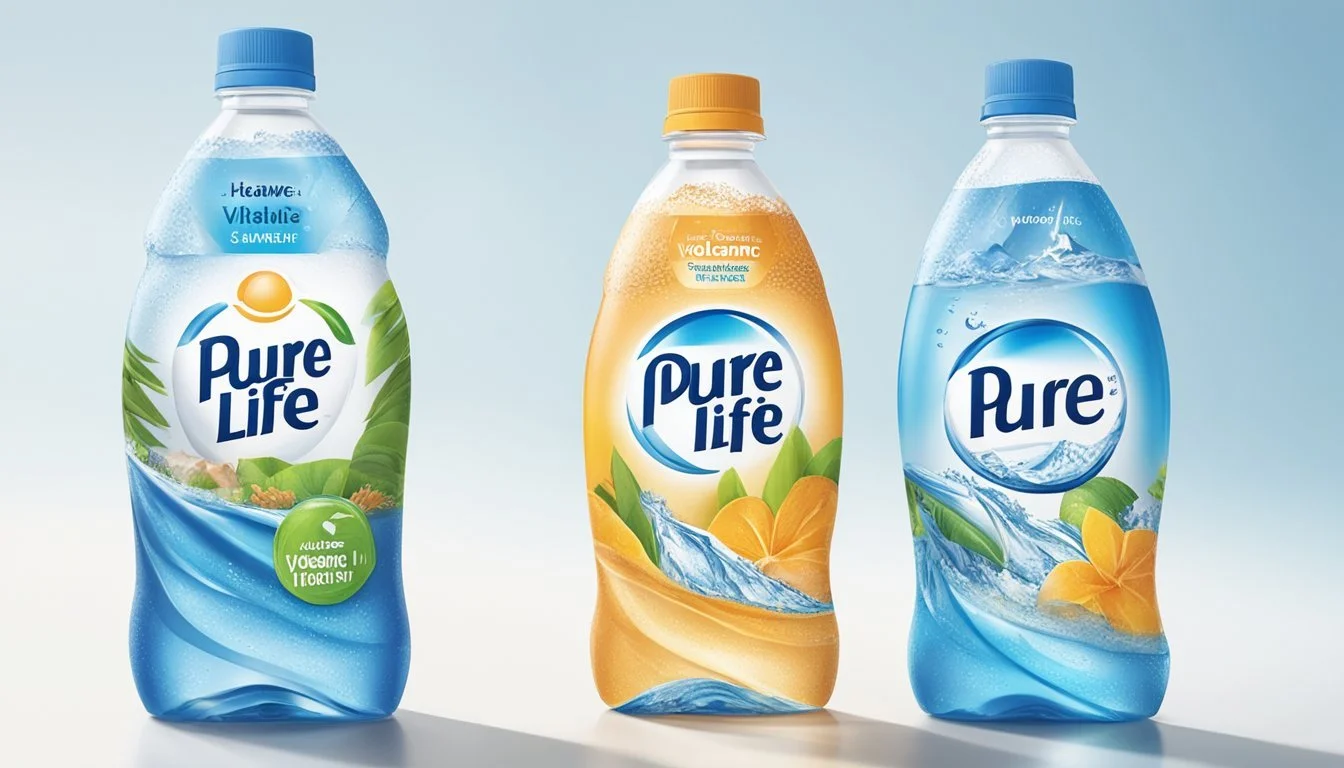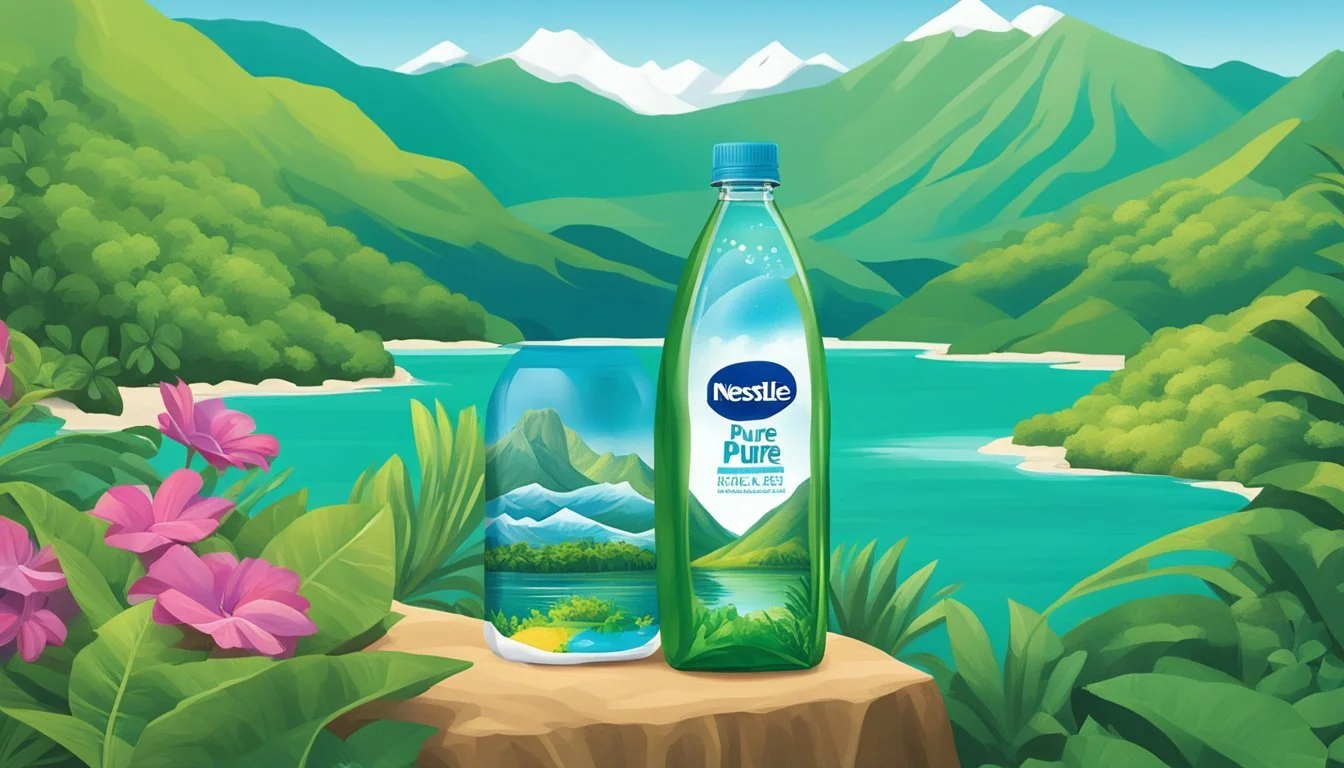Nestlé Pure Life vs. Hawai’i Volcanic
Comparative Analysis of Bottled Water Quality
In the quest to determine which bottled water stands superior—Nestlé Pure Life or Hawai’i Volcanic—several key factors come into play. Nestlé Pure Life, known for its global presence and consistency, offers reliable hydration without any significant taste distraction. Comparatively, Hawai’i Volcanic touts its premium purity, derived from the remote and pristine volcanic aquifers of Hawaii.
While both brands strive for quality, their differences highlight unique appeals. Nestlé Pure Life leverages advanced purification processes to ensure a clean and dependable taste, making it a household favorite. Hawai’i Volcanic, on the other hand, emphasizes its natural origins and higher mineral content, catering to those seeking a more natural and potentially healthier option.
Ultimately, the choice between Nestlé Pure Life and Hawai’i Volcanic depends on personal preferences surrounding purity, taste, and sourcing integrity. Each brand shines in its own right, offering distinct advantages that cater to various consumer needs.
Comparing Sources
In evaluating the sources of Nestlé Pure Life and Hawai’i Volcanic, it is crucial to understand their origins and how they impact quality and sustainability.
Origin of Nestlé Pure Life
Nestlé Pure Life is sourced from various locations worldwide. This water often originates from local municipal supplies that are thoroughly purified through multiple stages.
Most of Nestlé's sources include groundwater from protected wells or springs and are then treated to ensure safety. The process involves techniques such as reverse osmosis and carbon filtration.
Nestlé, being the world’s largest bottled water company, emphasizes accessibility. The broad network of sources allows them to meet high demand. Despite criticisms regarding water source transparency, they maintain rigorous quality standards.
Hawai’i Volcanic Nature
Hawai'i Volcanic water comes from the pristine Mauna Loa volcano, a highly acclaimed source due to the unique geography.
The water is naturally filtered through porous lava rock. This process enriches the water with essential minerals and electrolytes, resulting in a crisp, refreshing taste. The volcanic aquifers supply rainwater that has been naturally purified over many years.
The company markets this water as not only healthy but also ethically sourced. They promote sustainability by focusing on eco-friendly packaging and supporting local communities. Such ethical practices and the extraordinary source contribute to its premium status in the bottled water market.
Chemical Composition and Health Benefits
Nestlé Pure Life and Hawai’i Volcanic differ significantly in their chemical compositions, directly impacting their health benefits. This section highlights their mineral content, pH balance, alkalinity, and electrolyte roles.
Mineral Content Analysis
Nestlé Pure Life includes calcium chloride, sodium bicarbonate, and magnesium sulfate. These minerals aid in maintaining healthy bones, nerve function, and muscle performance.
Hawai’i Volcanic boasts a unique profile due to volcanic filtration, which enriches the water with silica, magnesium, and potassium. Silica promotes collagen production, enhancing skin health. Magnesium and potassium contribute to cardiovascular health and muscle function.
Mineral Nestlé Pure Life Hawai’i Volcanic Calcium Present Present (Volcanic) Magnesium Present Present (Volcanic) Potassium Absent Present (Volcanic) Silica Absent Present (Volcanic)
PH Balance and Alkalinity
The pH balance and alkalinity of water can significantly affect bodily functions. Nestlé Pure Life holds a neutral pH close to 7, suitable for general hydration without drastically altering the body's pH.
Hawai’i Volcanic, often marketed as alkaline water, typically exhibits a pH range of 8-9.5. Alkaline water supporters claim that higher pH levels can help neutralize acid in the bloodstream, helping with acid reflux and enhancing metabolism.
PH Range Comparison:
Nestlé Pure Life: ~7
Hawai’i Volcanic: 8-9.5
Role of Electrolytes
Electrolytes are crucial for hydration, muscle function, and nerve signaling. Nestlé Pure Life is fortified with common electrolytes, including sodium and magnesium.
Hawai’i Volcanic contains naturally occurring electrolytes like potassium and magnesium, which are beneficial to athletes and individuals with high physical activity due to their role in preventing muscle cramps and enhancing endurance.
Electrolyte Function Nestlé Pure Life Hawai’i Volcanic Sodium Hydration, Nerve Function Present Absent Magnesium Muscle Function, Nerve Signaling Present Present Potassium Heart Function, Muscle Contraction Absent Present
Both brands offer distinct advantages based on their unique compositions, supporting different health goals and preferences.
Environmental Impact and Sustainability
Nestlé Pure Life and Hawai’i Volcanic approach environmental impact and sustainability through various initiatives focusing on packaging, sourcing, and community contributions. Here is a detailed look at their efforts in these areas.
Packaging and Recycling Efforts
Nestlé Pure Life uses plastic bottles, and their focus is on promoting recycling to mitigate environmental waste. They emphasize the use of RPET (Recycled PET), aiming for 100% recycled plastic in their bottles. Despite these efforts, the recycling rate remains a challenge, with only 50% of PET bottles being recycled. This highlights the importance of developing a circular economy.
Hawai’i Volcanic, on the other hand, aims for an environmentally friendly approach by using reusable bottles and materials that are easier to recycle. Their bottles often contain RPET and their messaging encourages consumers to support sustainable practices by choosing products with a lower environmental footprint.
Sourcing and Environmental Policies
Nestlé Pure Life sources water using methods designed to minimize resource use, requiring less than 2.5 liters of water to produce one liter of bottled water. This is more efficient compared to other beverages like beer. They collaborate with public authorities and NGOs to improve sustainability and conservation practices. They also focus on reducing their carbon footprint through energy-efficient practices and sustainable transport options.
Hawai’i Volcanic sustainably sources its water from natural volcanic springs, supporting conservation and maintaining the natural ecosystem. They focus on ethical sourcing with a strong commitment to preserving the natural environment. Policies may include reduced carbon emissions, effective waste management, and responsible use of water resources.
Community and Global Contributions
Nestlé Pure Life emphasizes giving back through initiatives like Pump Aid, which provides clean water access in areas like Malawi, Africa. Their focus is on creating education opportunities, promoting community health, and supporting local economies. Nestlé collaborates with various stakeholders to enhance community well-being and sustainability.
Hawai’i Volcanic supports local conservation efforts and engages in global initiatives that focus on clean water access and environmental education. They emphasize the pono philosophy, which means righteousness, benefitting both the community and the environment. They actively participate in support and conservation projects that strive to make a positive impact on a global scale.
Taste and Palatability
Taste and palatability are crucial factors in determining the preference for bottled water brands. Both Nestlé Pure Life and Hawai’i Volcanic offer distinct profiles that appeal to different segments of the market.
Flavor Profile Comparison
Nestlé Pure Life is classified as purified water. Its flavor profile is characterized by a clean and neutral taste, achieved through rigorous purification processes. This results in a lack of detectable minerals, which some consumers appreciate for its simplicity and predictability.
Hawai’i Volcanic, on the other hand, is natural artesian water sourced from Hawaiian volcanic springs. It has a distinct, slightly mineral-rich taste, attributed to its natural filtration through volcanic rock. This process imparts a smooth and refreshing quality, enhanced by subtle mineral content that some customers find particularly appealing.
Customer Preference Studies
Various studies and blind taste tests indicate varying customer preferences. Nestlé Pure Life appeals to customers looking for a no-frills, clean-tasting option. Its neutral taste ensures that it does not interfere with other flavors, making it a versatile choice.
Hawai’i Volcanic garners positive reviews for its unique mineral taste and natural smoothness. Customers often highlight its refreshing and slightly sweet undertone, which sets it apart from more common bottled waters. When participants in blind taste tests were asked to rank on preference, Hawai’i Volcanic often scored higher among those who enjoy a more pronounced mineral flavor.
Both brands have their loyalists, with preferences largely split between those who favor a pure, neutral taste and those who appreciate a more distinct, mineral-enhanced flavor.
Product Variants and Accessibility
Nestlé Pure Life and Hawai’i Volcanic present different options for consumers in terms of bottle sizes and market availability. They aim to cater to convenience, premium experiences, and specific market demands.
Bottle Sizes and Types
Nestlé Pure Life offers a wide range of bottle sizes to suit various needs. Common sizes include 500ml, 700ml, and 1.5L plastic bottles. These bottles are often designed for single-use convenience but can also be found in multipack offers, making it easier for bulk purchasing.
Hawai’i Volcanic, catering to a premium market, provides options such as 500ml and 1L. They emphasize sustainability and often package their water in reusable and recyclable materials. This includes premium packaging like glass bottles to appeal to environmentally-conscious consumers.
Market Availability and Offers
Nestlé Pure Life is widely accessible in various markets. It is commonly found in supermarkets, convenience stores, and online platforms like Amazon. They also offer subscription services to ensure consistent delivery, enhancing its convenience factor. Whole Foods Market is one notable retailer where it is readily available.
Hawai’i Volcanic targets niche markets and is available in high-end grocery stores and health food outlets. They also promote online ordering with subscription models. Special offers are often available at retailers like Whole Foods Market, especially for bulk purchases, appealing to premium consumers seeking eco-friendly options.
Pricing and Value Proposition
Nestlé Pure Life offers competitive pricing, making it an accessible option for many consumers. Their market positioning leans towards affordability, often found in bulk packages at grocery stores and big-box retailers. This strategy helps them maintain a broad market reach.
In contrast, Hawai’i Volcanic is situated as a premium bottled water brand. Its higher price reflects the cost of sourcing and the unique volcanic filtering process, which appeals to consumers seeking top-tier hydration.
Brand Price Range (per bottle) Market Position Nestlé Pure Life $0.50 - $1.00 Affordable Hawai’i Volcanic $1.50 - $3.00 Premium
Value Proposition:
Nestlé Pure Life: Emphasizes value-for-money, suitable for everyday consumption without breaking the bank. Ideal for budget-conscious consumers.
Hawai’i Volcanic: Promotes unique sourcing from Hawaiian volcanic sources. Marketed as some of the best water in the world, targeting those who prioritize quality and source authenticity.
Consumers looking for cost-effective hydration might prefer Nestlé Pure Life. Those willing to invest more for premium qualities might lean towards Hawai’i Volcanic. Each brand caters to different market segments based on pricing and perceived value.
Final Assessment and Recommendations
Taste:
Nestlé Pure Life is often described as having a neutral taste. Hawai’i Volcanic, on the other hand, is noted for a slightly crisp and clean taste profile. Preference here may depend on individual palates.
Cost:
Nestlé Pure Life is more affordable, making it accessible for daily consumption. Hawai’i Volcanic, due to its origin and premium positioning, tends to be pricier.
Health Benefits:
Nestlé Pure Life goes through a purification process that ensures it is safe for drinking, but it lacks significant additional minerals. Hawai’i Volcanic claims to contain natural minerals from volcanic rocks, which may offer some health benefits.
Sustainability:
Nestlé has taken steps to reduce plastic usage, but it still faces criticism over environmental impacts. Hawai’i Volcanic emphasizes its use of recyclable materials and eco-friendly practices, potentially offering a better choice for the environmentally conscious.
Environmental Impact:
Both brands contribute to plastic waste, but the scope and nature differ. Nestlé faces scrutiny concerning its extraction practices. Hawai’i Volcanic's environmentally friendly packaging and sustainable sourcing are perceived positively.
Recommendations:
For those prioritizing cost and availability, Nestlé Pure Life is an efficient option. For consumers who value taste, health benefits, and sustainability, Hawai’i Volcanic may be more appealing despite the higher price. The choice largely depends on personal priorities and budget.
More About Nestlé Pure Life
Acqua Panna vs Nestle Pure Life: Which Bottled Water is Better?
Aquafina vs Nestle Pure Life: Which Bottled Water is Better?
Arrowhead vs Nestle Pure Life: Which Bottled Water is Better?
Boxed Water vs Nestle Pure Life: Which Bottled Water is Better?
Core Hydration vs Nestle Pure Life: Which Bottled Water is Better?
Deer Park vs Nestle Pure Life: Which Bottled Water is Better?
Essentia vs Nestle Pure Life: Which Bottled Water is Better?
Ice Mountain vs Nestle Pure Life: Which Bottled Water is Better?
Icelandic Glacial vs Nestle Pure Life: Which Bottled Water is Better?
Just Water vs Nestle Pure Life: Which Bottled Water is Better?
Mountain Valley Spring Water vs Nestle Pure Life: Which Bottled Water is Better?
Nestle Pure Life vs 1907water: Which Bottled Water is Better?
Nestle Pure Life vs 7-Select: Which Bottled Water is Better?
Nestle Pure Life vs Alkaline88: Which Bottled Water is Better?
Nestle Pure Life vs Antipodes: Which Bottled Water is Better?
Nestle Pure Life vs Aqua Carpatica: Which Bottled Water is Better?
Nestle Pure Life vs Big Chill: Which Bottled Water is Better?
Nestle Pure Life vs BodyArmor: Which Bottled Water is Better?
Nestle Pure Life vs Cascade Mountain: Which Bottled Water is Better?
Nestle Pure Life vs Castle Rock: Which Bottled Water is Better?
Nestle Pure Life vs CBD Living: Which Bottled Water is Better?
Nestle Pure Life vs Crystal Geyser: Which Bottled Water is Better?
Nestle Pure Life vs Crystal Lake: Which Bottled Water is Better?
Nestle Pure Life vs Essence pH10: Which Bottled Water is Better?
Nestle Pure Life vs Hawaiian Springs: Which Bottled Water is Better?
Nestle Pure Life vs Kirkland Signature: Which Bottled Water is Better?
Nestle Pure Life vs Liquid Death: Which Bottled Water is Better?
Nestle Pure Life vs Mananalu: Which Bottled Water is Better?
Nestle Pure Life vs Open Water: Which Bottled Water is Better?
Nestle Pure Life vs Poland Spring: Which Bottled Water is Better?
Nestle Pure Life vs Proud Source: Which Bottled Water is Better?
Nestle Pure Life vs Pure Life: Which Bottled Water is Better?
Nestle Pure Life vs Purely Sedona: Which Bottled Water is Better?
Nestle Pure Life vs Refreshe: Which Bottled Water is Better?
Nestle Pure Life vs Richard's Rainwater: Which Bottled Water is Better?
Nestle Pure Life vs San Pellegrino: Which Bottled Water is Better?
Nestle Pure Life vs Simple Truth: Which Bottled Water is Better?
Nestle Pure Life vs Smartwater: Which Bottled Water is Better?
Nestle Pure Life vs Solan de Cabras: Which Bottled Water is Better?
Nestle Pure Life vs Talking Rain AQA: Which Bottled Water is Better?
Nestle Pure Life vs The Well: Which Bottled Water is Better?
Nestle Pure Life vs Topo Chico: Which Bottled Water is Better?
Nestle Pure Life vs Tru Alka: Which Bottled Water is Better?
Nestle Pure Life vs Weird Water: Which Bottled Water is Better?
Nestle Pure Life vs Whole Foods 365: Which Bottled Water is Better?
Nestle Pure Life vs Whole Foods Italian Still Mineral water: Which Bottled Water is Better?
Nestle Pure Life vs Zephyrhills: Which Bottled Water is Better?
More About Hawai’i Volcanic
Acqua Pana vs Hawaii Volcanic: Which Bottled Water is Better?
Antipodes vs Hawaii Volcanic: Which Bottled Water is Better?
Aqua Carpatica vs Hawaii Volcanic: Which Bottled Water is Better?
Arrowhead vs Hawaii Volcanic: Which Bottled Water is Better?
Boxed Water vs Hawaii Volcanic: Which Bottled Water is Better?
Castle Rock vs Hawaii Volcanic: Which Bottled Water is Better?
Core Hydration vs Hawaii Volcanic: Which Bottled Water is Better?
Deer Park vs Hawaii Volcanic: Which Bottled Water is Better?
Hawaii Volcanic vs 1907water: Which Bottled Water is Better?
Hawaii Volcanic vs Alkaline88: Which Bottled Water is Better?
Hawaii Volcanic vs Big Chill: Which Bottled Water is Better?
Hawaii Volcanic vs BodyArmor: Which Bottled Water is Better?
Hawaii Volcanic vs Cascade Mountain: Which Bottled Water is Better?
Hawaii Volcanic vs CBD Living: Which Bottled Water is Better?
Hawaii Volcanic vs Crystal Geyser: Which Bottled Water is Better?
Hawaii Volcanic vs Crystal Lake: Which Bottled Water is Better?
Hawaii Volcanic vs Essence pH10: Which Bottled Water is Better?
Hawaii Volcanic vs Kirkland Signature: Which Bottled Water is Better?
Hawaii Volcanic vs Liquid Death: Which Bottled Water is Better?
Hawaii Volcanic vs Open Water: Which Bottled Water is Better?
Hawaii Volcanic vs Proud Source: Which Bottled Water is Better?
Hawaii Volcanic vs Pure Life: Which Bottled Water is Better?
Hawaii Volcanic vs Purely Sedona: Which Bottled Water is Better?
Hawaii Volcanic vs Richard's Rainwater: Which Bottled Water is Better?
Hawaii Volcanic vs Simple Truth: Which Bottled Water is Better?
Hawaii Volcanic vs Talking Rain AQA: Which Bottled Water is Better?
Hawaii Volcanic vs Weird Water: Which Bottled Water is Better?
Hawaii Volcanic vs Whole Foods 365: Which Bottled Water is Better?
Hawaii Volcanic vs Whole Foods Italian Still Mineral water: Which Bottled Water is Better?
Hawaiian Springs vs Hawaii Volcanic: Which Bottled Water is Better?
Ice Mountain vs Hawaii Volcanic: Which Bottled Water is Better?
Icelandic Glacial vs Hawaii Volcanic: Which Bottled Water is Better?
Just Water vs Hawaii Volcanic: Which Bottled Water is Better?
Mountain Valley Spring Water vs Hawaii Volcanic: Which Bottled Water is Better?
Poland Spring vs Hawaii Volcanic: Which Bottled Water is Better?
San Pellegrino vs Hawaii Volcanic: Which Bottled Water is Better?
Smartwater vs Hawaii Volcanic: Which Bottled Water is Better?
Solan de Cabras vs Hawaii Volcanic: Which Bottled Water is Better?
Topo Chico vs Hawaii Volcanic: Which Bottled Water is Better?
Zephyrhills vs Hawaii Volcanic: Which Bottled Water is Better?









